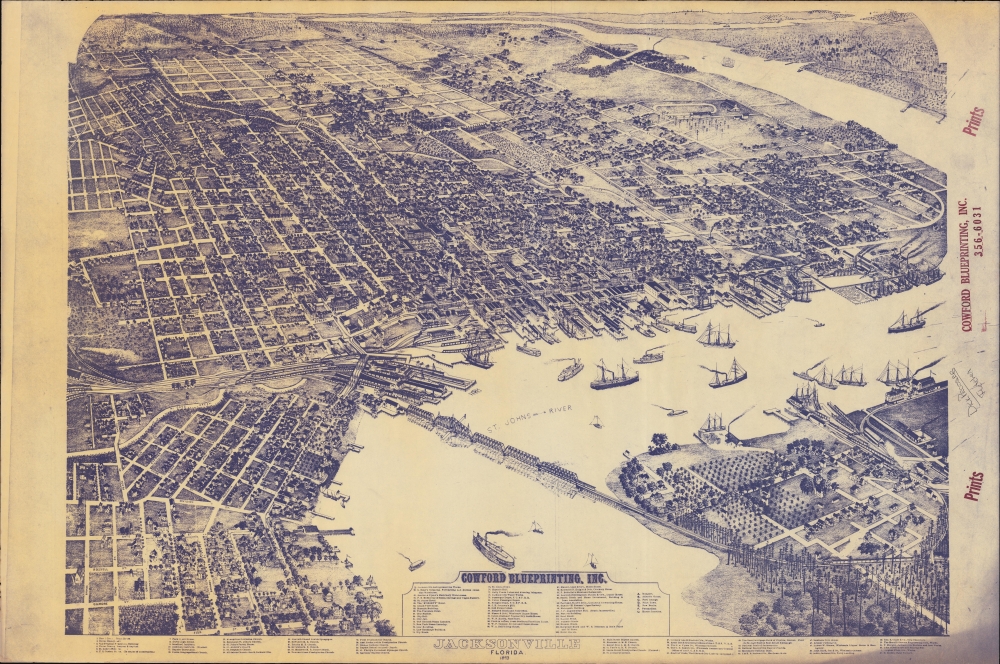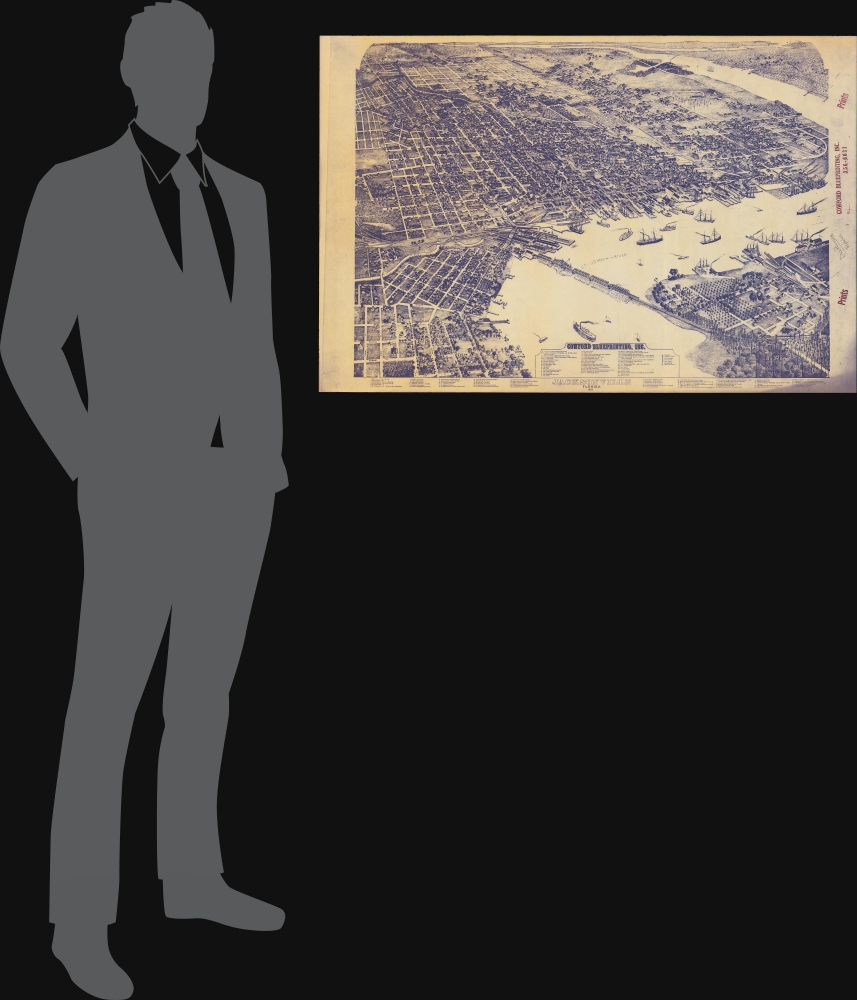This item has been sold, but you can get on the Waitlist to be notified if another example becomes available.
1960s Koch / Cowford Diazo View of Jacksonville, Florida
Jacksonville-koch-1960
Title
1960 (dated) 24 x 36 in (60.96 x 91.44 cm)
Description
A Closer Look
The view offers a Koch's signature high-oblique perspective on Jacksonville with a slightly northeasterly orientation. The St. John's River appears in the foreground, with Jacksonville's historic downtown at center. The St. John's River Bridge (Acosta Bridge) is revealed in its original format, as a railroad bridge constructed by Henry Flagler in the 1890s. Some 108 businesses are identified in an inset table, as well as 7 other important locations. Below the bottom border an additional 57 buildings, churches, and business are noted. The Cowford stamp appears at right.Diazo Print or Whiteprint
The diazo print (whiteprint or diazo for short) is a photo reproductive technique best understood as a reverse cyanotype or blueprint. The process yields distinctive blue lines on white paper. Like cyanotypes, the diazo process gained popularity in architecture circles, where it was a simple and effective way to duplicate documents in the field. The earliest diazotypes appeared around 1880 and were adopted for military and field cartographic use from about 1895. The diazo process was commercialized in 1923, when the German firm, Kalle and Company, developed Ozalid, a patented diazo paper that made diazotyping even easier. By the 1950s, it supplemented cyanotypes as the reprographic technique of choice for technical drawings. It was later replaced with black-line diaziotypes, in the 1960s, and then digital prints in the 1980s.Publication History and Census
This view was originally drawn by Augustus Koch and published in chromolithograph in 1893 by Hudson-Kimberly Inc (Reps #705). The present blueprint variant, likely printed in the 1960s, has been updated to promote Cowford Blueprinting, with new internal content (Reps #706). Cowford is remarkable elusive. We did find corporate records for a Jacksonville company of that name, or alternately Cowford/Anderson Reprographics (1977 - 1993), but whether this is the same company, a name inherited from an older version of the firm, or a completely different company, we cannot determine. This piece is known in just two examples, the present offering, and a holding at the Florida Bureau of Historic Sites and Properties, Archives, Tallahassee, Florida.Cartographer
Augustus Koch (October 15, 1834 - 1901), active in the late 19th century, was one of the most prolific and widely traveled artists specializing in American city bird's-eye views. Koch was born in Birnbaum, Germany where, according to his superior officers in the Engineers Office of the Wisconsin Infantry during the Civil War, he received an excellent education. Some have speculated that he may have immigrated to the United States young and been educated here, but this seems unlikely as he retained a very strong German accent throughout his life. Koch enlisted as a private in the Wisconsin regiment during the American Civil War. He applied and was approved for an officer's commission in 1863. He was assigned as engineering officer to one of the black regiments serving in the Lower Mississippi Valley. There is produced several maps including one of Vicksburg. Koch started producing bird's-eye views after the Civil War with his first published view, Cedar Falls, Iowa, appearing around 1868. Koch may have apprenticed with Albert Ruger, another important Wisconsin view maker, and it may have been Ruger who introduced him to Joseph Stoner, who published many of his most significant views. According to John W. Reps, in Views and Viewmakers of Urban America (Page185),
Koch drew his cities with considerable care, consistently depicting his subjects as if seen from very high viewpoints. The horizon lines appear close to the tops of the images, and the body of each print is thus full of urban detail. Koch also used a distinctive format, making his horizontal dimension not much greater than the vertical.The date of Koch's death is unknown. His career saw the publication of some 110 views in at least 23 different states. More by this mapmaker...




